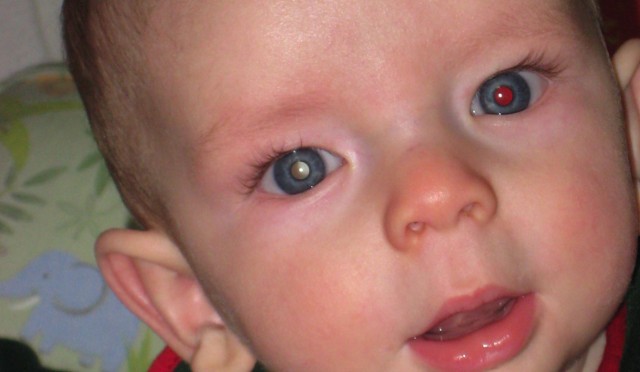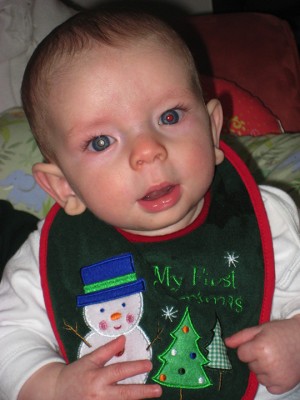Dr. Bryan Shaw is a cool guy. Hands behind his head and feet propped up on his desk, interactions with him feel more like chatting with a hip uncle than speaking to a passionate scientist.
Give him just a few minutes, though, and that appetite for scientific discovery will shine through, revealing the brilliant mind that has helped take serious ground in the fight against pediatric eye cancer using photography.
Shaw, an assistant professor in Baylor’s chemistry and biochemistry department, has spent roughly five years researching Retinoblastoma, an eye cancer that has affected his own now 5-year-old son, using flash photography.
“Every picture you take can be a retinal scan if it’s taken at the right angle,” Shaw said.
Retinoblastoma is an “exclusively pediatric” cancer, meaning only children are susceptible to the disease. This type of cancer affects the retina of the eye, and can occur in only one eye or, in the worst cases, both eyes.
“The retina is developing during approximately the first five years of life, so during that period, the retina is especially susceptible to mutations,” Shaw said.
The appearance of white-eye, or leukocoria, in photographs has helped diagnose Retinoblastoma in many children, Shaw said.
Like the “red-eye” phenomenon seen in flash photography, white-eye occurs when light shining into the retina is reflected back out of the eye and into the lens of the camera.
Retinal tumors cause the light reflected back into the camera to appear white instead of a normal red color.
Shaw and his research team analyzed 9,000 pictures of his son from birth to 3 years old to discover how much information photographs can convey about Retinoblastoma.
Shaw’s son developed the cancer by at least 12 days old, but the disease was not detected until he was 3 months old and the cancer was in both eyes.
Shaw said his team was the first to analyze the progression of white-eye in family photographs from the phenomenon’s first detection through treatment and into remission.
Allen junior Rebecca Holden, a chemistry major, began working with Shaw’s research team during her freshman year at Baylor. She said she was not aware of the magnitude of the research until she began her job of reading over information and double-checking research.
“I approached Dr. Shaw for research opportunities and this is the project he needed help with at the time,” Holden said. “It wasn’t something I ever really expected to be working on, but I’m glad that I had the chance to work on a really unique project that is so helpful.”
In the U.S., many diagnoses of Retinoblastoma are made in enough time for patients to survive with some vision.
“Diagnosing it as early as possible means you’ll probably survive with better vision,” Shaw said. “In the U.S., if you get Retinoblastoma, you have a 95 percent of surviving, but you’re probably going to be losing some of your vision.”
Although the disease can be identified using photography, the detection of white-eye does not guarantee the preservation of vision.
“Most doctors and researchers have assumed that white eye is a symptom of advanced Retinoblastoma,” Shaw said. “By the time you detect white eye, it’s too late to save the eye.”
Shaw said cases of Retinoblastoma that occur in “research limited settings” like developing countries have a much higher mortality rate.
“In places like Haiti, India and parts of China, the survival rate can be below 50 percent,” he said. “About 8,000 kids get this disease every year globally, and about 4,000 die.”
This increased mortality rate occurs because of the nature of Retinoblastoma and a lack of detection.
“They die because they’re diagnosed after the disease has spread out of the eye,” he said. “As awful as it sounds, as long as it’s in the eye, you can just take the eye out, but it likes to spread straight down the optic nerve and into the brain.”
Shaw said his research can lead to parents being more empowered to catch the disease early in childhood.
“Eighty percent of diagnoses are initiated by a parent or relative noticing abnormal pupillary reflections in digital pictures,” he said. “Parents appear to be the front line.”
The team was able to create a “brightness” scale for white-eye, Shaw said. By looking at the photographs of Shaw’s son, the team formed the scale, showing how the infrequent white-eye of early photos was due to the tumors’ small size, while later photos with frequent white-eye were the result of tumor growth.
“It initially occurred at 12 days old, but it only occurred in a small percent of the pictures that were taken in that first month of life,” Shaw said. “As the tumors got bigger, some days we would see leukocoria in almost every picture.”
Shaw said this discovery has led to the belief that parents often miss the early signs of RB because of the infrequent occurrence of white-eye during the early stages of the cancer.
“Leukocoria can be a symptom of early-stage Retinoblastoma, but it occurs infrequently, so it’s probably easily missed by the parents,” he said. “Once the tumors get real big, then it starts showing up frequently, and this is probably when the parents start to detect it.”
Holden said participating in Shaw’s research team has reminded her of scientific research’s role in society.
“We’ve done a lot of work that is going to help a lot of people,” she said. “I was reminded that the end goal is the most important thing. This research reinforced that for me.”
Shaw said motivation to perform his work comes from a love for both science and his son.
“Sixty percent of me does this because I’m a scientist — 40 percent of me does it because I’m concerned with children who develop Retinoblastoma,” he said. “Other days it’s 100 percent ‘I just want to help the kids.’”
Shaw said he and his wife hope the trials they have experienced with their son will help others who are facing the same struggles.
“All this tough stuff we’re going through may end up helping other people out,” Shaw said. “I hope one day my son will be able to put this into perspective and can say that God used his trial to help other people out.”
Shaw said parents of a child facing cancer should not be afraid of the trials before them.
“Kids are great, even if they come to you with tumors,” he said. “I love my son, and I can’t ever imagine not loving my son, but I know that I love him even more now that he has this cancer.”



